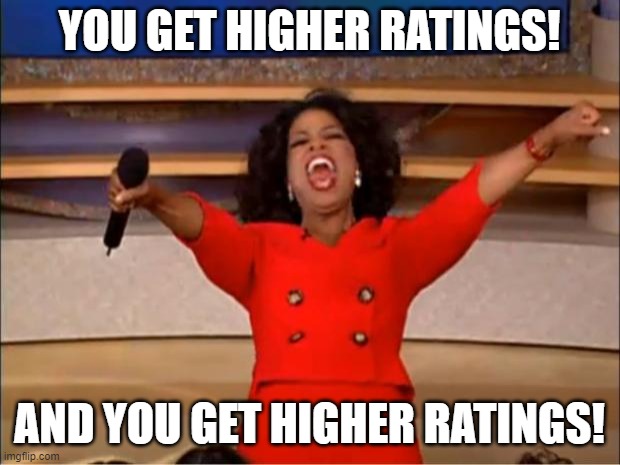
In an otherwise lackluster, even disappointing year in radio, there is something very fortuitous and potentially even wonderful on the horizon. And for that, radio operators will have Nielsen to thank.
Now that may seem counter-intuitive. After all, very little good news ever seems to emanate from “the ratings company of record.” Whether it’s Arbitron, Nielsen, or a ratings company to be named later, radio broadcasters have long considered the company that supplies what’s known as “ratings currency” similarly to how most of us regard the IRS – a necessary evil that takes boxcars filled with money in exchange for numbers that are often dissatisfying at best.
Now to the hard-working, well-meaning people who tirelessly try to keep the ratings system balanced and equitable, this treatment is hardly fair. Most of them worked in the radio business at one time or another, so they feel our pain.
But this year end could be different, with the promise of wrapped presents sitting under the tree from Nielsen, filled with good tidings, and more importantly, better ratings for all. At least, that’s the hope. In a webinar hosted by the Nielsen Audio team yesterday, a new ratings plan for PPM markets was unveiled. And even though it sounded like a bunch of political promises in an election year, the fact is, the new Nielsen “3 Minute Plan” ought to deliver on the promise.
In case you somehow missed it – and the ratings company has been in close touch with its radio clients for months – Nielsen is proposing to sweeten up the formula that awards those all-important quarter-hour credits to stations. For the past 100 years (seriously), the hard and fast rule required 5 minutes of listening (not contiguous) to a radio station in order to receive a quarter-hour credit. But in this age of virtually infinite choice, deteriorating attention spans, and short songs that are three minutes in duration or less, radio stations have gotten screwed out of quarter-hours racking up on their side of the ledger.
I won’t go into the insidious ways stations can lose their grip on quarter-hours during the course of a listening span, but they are numerous and they’re painful. In fact, Nielsen explained during yesterday’s webinar that nearly HALF of all radio listening occasions come up short for quarter-hour credit because they are less than five minutes in duration. And you wonder why radio programmers often appear to be unstable and develop nervous tics.
But now a rule’s change would alleviate much of this pain and suffering. That’s because the 5-minute requirement is being reduced to 3 minutes. And while this may not sound like a major change, Nielsen’s actual numbers recalculated to this new standard generates an average AQH increase of 26% in the total 6+ population.
That’s not a typo. It’s not 2.6% (although even that would be a welcome boost right about now).
It’s TWENTY-SIX FREAKING PERCENT!!
Nielsen spent the rest of the webinar slicing and dicing the numbers – by age demographic, by format, and by market. And it’s ALL GOOD. As Oprah might say, “Everybody gets higher ratings!”
Pretty much. And in a nasty world where there is higher AQH listening in old school, Neanderthal paper diaries than there is with those sleek meters, Nielsen’s proposed rules change was welcome news to radio broadcasters who have been whining about PPM for the past 17 years.
Notice I used the word “proposed.” Because as Nielsen Audio chieftain Rich Tunkel reminded the assembled Zoom-sters, radio broadcasters have some decisions to make. Do they really want to change the AQH crediting rules right now? And if so, when would they want “The 3 Minute Rule” to become the new law of Radioland?
I know. These are tough questions. To anticipate how these calls might go, I offer the following role playing example I completely made up:
Nielsen rep: “So what do you think? Do you really want to go through with this?”
Mr./Ms. radio broadcaster: “Ugh, I think so. But I have a couple questions.”
Nielsen rep: “Shoot.”
Mr./Ms. radio broadcaster: “Seriously, how much is this going to cost us? Or will the price increase be backloaded to the end of my contract so I can make it somebody else’s problem?”
Nielsen rep: “Not a shekel more. We just need to figure out the switch or two we’ll need to flip to get this going.”
Mr./Mrs. radio broadcaster: “You’re not going to cut back the sample size in my markets in order to pay for this new service, are you?”
Nielsen rep: “Not a chance. It’ll be the same everything, except for the adjustment you’ll likely have to make to deal with the idea of having much better ratings than you have now.”
Mr./Ms. radio broadcaster: “Will the book, the numbers, the measurement change?”
Nielsen rep: “Nope, same as it ever was; daily cume, weekly cume, daily AQH, weekly AQH, PUMM, you name it. It’ll all be there for your sellers and your clients.”
Mr./Ms. radio broadcaster: “Now tell me, how soon could we do this?”
Nielsen rep: “How soon do you want to do it? If you and your peers got moving, we might be able to get our plan together before Ryan Seacrest drops the ball in Times Square. Certainly, in Q1 2025. It just depends how eager you are to get considerably higher numbers for your beleaguered radio stations.”
Hopefully, this exercise prepares you for what promises to be a gritty exchange. You might even want to grab that copy of You Can Negotiate Anything that’s been gathering dust in your office in preparation for this tete-a-tete with your brutal Nielsen rep.
As the Nielsen team admitted on the webinar, they don’t exactly know how the voting will work. Will companies get one vote per station, sort of like the House of Representatives? Or will Bob Pittman and Bud Walters each get just one vote, sort of like in the Senate? And if there is somehow a tie, will Erica Farber be coaxed out of retirement to break it?
TBD, apparently.
But given how well political elections already run in this country, there’s no reason to believe radio broadcasters and Nielsen won’t find an equitable way to work through this process because it’s in everyone’s best interest.
In all seriousness, this feels very much like a unique moment in time. After all, there aren’t many times when “the rules” change to this magnitude, potentially altering the entire landscape. I think back to the initial PPM rollout. Back in those days, Arbitron would convene “Fly-Ins” – multi-day affairs to walk the industry through the changes and to discuss ramifications and even strategies. Back when meters replaced diaries in the nation’s biggest markets, a couple hundred broadcasters, researchers, and consultants flew to Laurel, Maryland, at their own expense to take in the new ratings methodology and understand what it might mean to the business.
Now we have Zoom and that’s what yesterday’s presentation was all about.
So, what might this mean to radio in both the short and long run?
A look at Nielsen’s initial test back in May of this year indicates pretty much everyone’s ratings will go up, some more than others, of course. Depending on the age of your audience, your format, and of course your “brand strength” (let’s not forget this one), your mileage will vary under this new “3 minute rule.” Nielsen revealed that stations with a younger audience and formats that skew toward a more youthful target may have an edge.
Music formats (where most programming elements are shorter to begin with) might also have an advantage over spoken word formats like sports where segments run longer. But within the roster of music formats, some – like Alternative, Hot AC, and CHR – look more robust. That said, Classic Rock would also seem to have a leg up on many other music formats, and of course, that warms this consultant’s grizzled radio heart.

What will this new measurement change mean to public radio, particularly NPR news stations? No detail there from Nielsen. So, that’s a conversation that will need to happen.
Like any change this sweeping, other questions are raised. And that should motivate companies and stations to revisit their practices regarding their programming and how it will be measured by Nielsen going forward.
- Will stopset placement be rethought? On the webinar, Nielsen acknowledged how most stations now use “bowtie” stopsets. But given this change to a 3-minute capture of quarter-hours, maybe more variants will appear. Perhaps, some will consider changes to their commercial loads (gasp!) and even the number of stopsets per hour in most clocks.
- Might this new measurement system even stimulate experimentation with younger targeted formats? Given how the lack of youth-targeted stations is radio’s “kryptonite,” the “3 minute rule” might stimulate new conversations?
- To this point, broadcasters have let PPM alter the sound of their stations – mostly to their detriment. Will improved numbers loosen up playlists and other “PPM rules” or will most stations end up sounding the same as they do now?
- On the sales end, will higher average ratings increase ad prices or will too many stations and companies allow agencies to cram them down on rates? Concurrently, will clusters continue to lower rates to increase share, or will the industry realize that higher ratings can mean higher rates? And will the industry come together and market its potentially higher overall reach to improve its image and perceived value with advertisers?
Undoubtedly, you and your team will have other questions. More information will also be released by Nielsen over time, providing the industry with more foundational knowledge.
Overall, this is the best news radio has enjoyed this year. Kudos to Nielsen for moving on these changes with care and speed simultaneously. And appropriately, they are letting their clients – radio broadcasters – make the call on timing and implementation.
Let’s not screw this up.
Contact your Nielsen rep for specific information for your market and for a copy of yesterday’s deck.
If you’d like to talk about your company, your market, your station, or your baseball team, contact us. – FJ
Originally published by Jacobs Media









